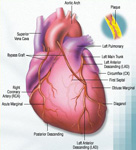New therapy may help reverse damage to blood vessels after heart attack

Washington, Sept 11: Scientists at Ohio State University say that they have discovered why blood vessels constrict during and after a heart attack.
The researchers say that delivering a vital molecule that is depleted during this process directly to those blood vessels can reverse damage and help restore blood flow.
According to them, the new findings are significant because they have the potential to improve outcomes for patients with acute coronary episodes related to ischemia, and to improve the restriction of blood supply to the heart.
"This is a useful therapeutic approach and should be easy to translate," said Jay L. Zweier, director of the Davis Heart and Lung Research Institute at Ohio State University Medical Center, and senior author of the study published in the journal Proceedings of the National Academy of Sciences.
"This should enable improved treatment of patients with unstable coronary syndromes and heart attacks, allowing enhanced restoration of blood flow and preservation of heart muscle at risk," he added.
Following a heart attack, blood vessels around the heart do not properly dilate and may constrict because of problems in the cells that line the vessel walls, according to the background information in the report.
Zweier and colleagues set out to determine the cascade of events that leads to the loss of vessel vasodilatory function and, in the process, identified a potential solution that would dilate and reopen vessels, improving blood flow.
The researchers have found that in hearts subjected to a lack of blood flow, or the ischemia that occurs during a heart attack, the ability of the vessels to remain dilated gets impaired because the production of the nitric oxide molecule that dilates the vessel stops. They say that this stoppage can be traced to depletion during ischemia of a molecule that is a critical cofactor required to activate the enzyme nitric oxide synthase (NOS), which produces the potent vasodilator nitric oxide. This critical cofactor is a molecule called tetrahydrobiopterin, or BH4.
"This is a useful therapeutic approach and should be easy to translate. This should enable improved treatment of patients with unstable coronary syndromes and heart attacks, allowing enhanced restoration of blood flow and preservation of heart muscle at risk."
The loss of BH4 during ischemia not only prevents production of nitric oxide and the dilation it causes, but actually causes the enzyme NOS to completely reverse course and instead produce an oxidant called superoxide that leads to constriction of the vessels.
Zweier found that the longer that blood flow is stopped during a cardiac event, the more severe the loss of BH4 - meaning the chances of restoring blood flow are increasingly reduced. The study showed a marked loss of BH4 after 30 minutes without blood flow, and more than 90 per cent depletion after 45 minutes.
"What wasn't known before was that as the time of ischemia progresses, the function of the enzyme is impaired and subsequent coronary flow is reduced. There is loss of enzyme function plus the switch from dilation to constriction," said Zweier, also a professor of internal medicine.
"Following a heart attack, vessels tend to constrict and mircovascular occlusion occurs, but what you need is a patent circulation with dilated vessels for restoration of coronary flow, or the muscle will die."
Because depletion of BH4 during ischemia is irreversible, the heart and coronary vessels cannot generate their own repair - which has important consequences for efforts to restore blood flow. So the scientists also developed a way to package the molecule and deliver it directly to the vessels. They discovered that the treatment was effective in partially restoring the process that opens and dilates the vessels with improved coronary flow.
Zweier said that because this approach controls blood vessel function at the cellular level, BH4 infusion could be used not just for acute heart attack treatment, but also to help prevent new blockages of coronary arteries after procedures such as angioplasty or bypass surgery.
He said the depletion of BH4 likely results from the burst of free radicals associated with both ischemia and the shock of the reintroduction of flow.(With Inputs from ANI)